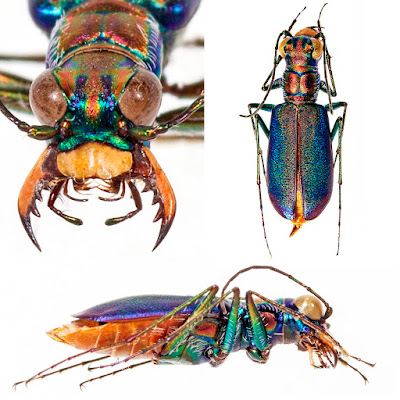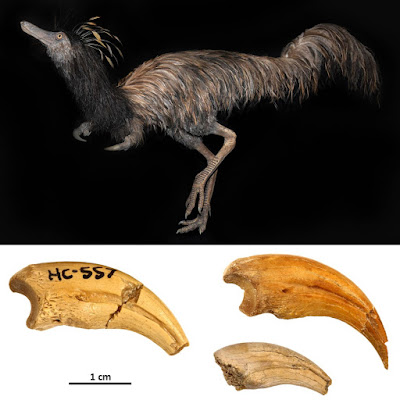[Most Recent Entries] [Calendar View]
Monday, July 13th, 2020
| Time | Event | ||||
| 1:44a | [Entomology • 2020] Cicindelidia cyanipleura • A New Tiger Beetle (Coleoptera, Cicindelidae) from the Trans-Mexican Volcanic Belt
Abstract A new tiger beetle species, Cicindelidia cyanipleura Duran and Roman n. sp., of the tribe Cicindelini, is described from the southwestern section of the Trans-Mexican Volcanic Belt. Superficially, it appears to be most closely related to C. rufiventris (Dejean, 1825) but is distinguished on the basis of multiple morphological characters and behavior. Given the rock-loving natural history of the species, escape behavior, polished pronotum, and small body size, it may be more closely related to the petrophiles C. laetipennis (Horn, 1913) or C. politula (LeConte, 1875), from which it is distinguished on the basis of multiple morphological characters and biogeography. Keywords: Coleoptera, Cicindelidia, new species, Jalisco, Mexico, taxonomy
Cicindelidia cyanipleura Duran & Roman, n. sp. Etymology. Cicindelidia cyanipleura n. sp. is named after the blue sides of the elytra and epipleura, derived from Greek: cyan- = blue, -pleura = side. Daniel P. Duran and Stephen J. Roman. 2020. A New Tiger Beetle from the Trans-Mexican Volcanic Belt (Coleoptera, Cicindelidae, Cicindelini). Zootaxa. 4810(2); 375–382. DOI: 10.11646/zootaxa.4810.2.11 | ||||
| 2:10a | [Paleontology • 2020] Trierarchuncus prairiensis • the Last Alvarezsaurid: Hell Creek Formation (uppermost Maastrichtian), Montana
Highlights • A growth series of hand claws and other fossil material from a new taxon, Trierarchuncus prairiensis, of the unusual theropod family Alvarezsauridae is described. • One claw is the most complete known for Alvarezsauridae and challenges assumptions about the lack of curvature in derived members of the group and demonstrates that alvarezsaurid claws could be of higher curvature than typically reconstructed. • The possible growth series suggests that alvarezsaurid manual unguals may have changed morphology through ontogeny, with younger individuals retaining more basal characteristics. This has implications for taxonomy and phylogeny of the group as some taxa are described based on probable juvenile remains. • Trierarchuncus derives from the uppermost Maastrichtian Hell Creek Formation of Montana, and is therefore the youngest known alvarezsaurid and was one of the very last dinosaurs, which went extinct at the K–Pg boundary mass extinction. Abstract The enigmatic Alvarezsauria (Dinosauria: Theropoda) are characterized by extremely short forelimbs with a single functional digit bearing a large, robust ungual. Alvarezsauria are first recorded from the Jurassic of China, but are otherwise mostly known from the Cretaceous of South America and Asia, including a number of relatively complete skeletons. North America has yielded only a fragmentary skeleton from the lower Maastrichtian Horseshoe Canyon Formation, Alberta, and a pubis, partial ischium, and metatarsal from the upper Maastrichtian Hell Creek Formation, Montana, and Lance Formation, Wyoming. Here we describe new alvarezsaurid material from the Hell Creek Formation, Montana, comprising a metatarsal III, distal end of a radius, and three manual digit (MD)-I unguals, which form a progressive size series. One MD-I ungual is the most complete yet described, and is much more curved than typically depicted for Alvarezsauridae. Manual D-I unguals are of particular interest as they undergo a number of changes within the clade, including enclosure of the ventral blood vessel groove, development of a ventral sulcus, and increased robusticity and rugosity. Comparison among the new specimens suggests that these features also develop ontogenetically, which may have taxonomic implications. Stratigraphic data shows that alvarezsaurids occur through most of the ∼85 m thick Hell Creek Formation, with the uppermost specimen occurring ∼10 m below the upper contact with the Fort Union Formation. As such these are the youngest known alvarezsaurid remains and demonstrate that the clade survived at least until ∼1–200 kyrs before the Cretaceous–Paleogene mass extinction. Keywords: Dinosaur, Theropoda, Alvarezsauridae, Mononykus, Hell Creek Formation, Late Cretaceous Systematic Paleontology Dinosauria Owen, 1842 Saurischia Seeley, 1888 Theropoda Marsh, 1881 Maniraptora Gauthier, 1986 Alvarezsauridae Bonaparte, 1991 Trierarchuncus prairiensis gen. et sp. nov. Derivation of name. The genus name refers to the 'trierarch', specifically a seafaring ship's captain (trirēmē ships of ancient Greece), and 'uncus' meaning hook (Latin). Species name means 'of the prairie', referring to the gentle plains of eastern Montana (in particular the American Prairie Reserve) where the new material was discovered. Denver W. Fowler, John P. Wilson, Elizabeth A. Freedman Fowler, Christopher R. Noto, Daniel Anduza and John R.Horner. 2020. Trierarchuncus prairiensis gen. et sp. nov., the last alvarezsaurid: Hell Creek Formation (uppermost Maastrichtian), Montana. Cretaceous Research. In Press. DOI: 10.1016/j.cretres.2020.104560 Trierarchuncus prairiensis (“Captain Hook of the prairie”): a new species of bizarre hook-handed alvarezsaurid dinosaur. | ||||
| 2:43a | [Crustacea • 2020] Nanoplax thomai & Pseudopanopeus pusillus • A New Crab of the Genus Nanoplax from the Gulf of Mexico, and Assignment of Micropanope pusilla to A New Genus (Brachyura, Pseudorhombilidae)
Abstract Nanoplax thomai n. sp. is described from the Gulf of Mexico, representing the second species of the genus. The description is based upon a number of specimens previously misidentified as Micropanope truncatifrons Rathbun, 1898, including one so represented in recent molecular phylogenetic analyses. As restricted, Micropanope truncatifrons remains known with certainty from only the limited type series, which does not include a mature male, and sequence quality tissues are not available for molecular phylogenetic analyses. Its generic placement remains questionable following morphological study of its type materials and comparisons to specimens representing other present and former members of Micropanope Stimpson, 1871. Those comparisons underscore that morphological and molecular distinctions warrant assignment of Micropanope pusilla A. Milne-Edwards, 1880 to a new genus, herein designated as Pseudopanopeus n. gen. Keywords: Crustacea, Pseudorhombilidae, Gulf of Mexico, Nanoplax, new species, generic revision Nanoplax thomai n. sp. Etymology. The species is named for Brent P. Thoma in recognition of his substantial contributions to understanding of xanthoid crab phylogenetic relationships and in gratitude for the many ways in which he has facilitated the present author’s work over the last decade
Pseudopanopeus n. gen. Etymology. The prefix “pseudo”, for false, is paired with the suffix “panopeus”, derived from the type genus of Panopeidae Ortmann, 1893. As the gender is masculine, its combination with the type species name becomes Pseudopanopeus pusillus (A. Milne-Edwards, 1880). While resembling panopeids in general habitus and long grouped among members of that family, this genus is one of several such that instead fall among Pseudorhombilidae in the phylogenetic analyses of Thoma et al. (2014). Pseudopanopeus pusillus (A. Milne-Edwards, 1880) n. comb. Micropanope pusilla A. Milne-Edwards, 1880 Darryl L. Felder. 2020. A New Crab of the Genus Nanoplax from the Gulf of Mexico, and Assignment of Micropanope pusilla to A New Genus (Crustacea, Brachyura, Pseudorhombilidae). Zootaxa. 4810(3); 531–545. DOI: 10.11646/zootaxa.4810.3.9 |
| << Previous Day |
2020/07/13 [Calendar] |
Next Day >> |








